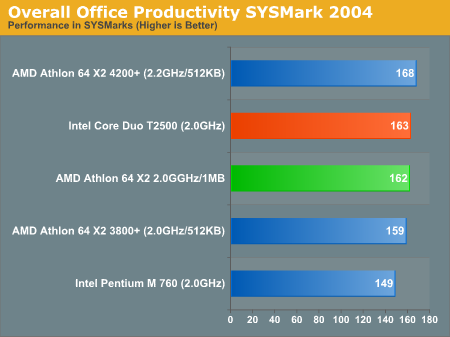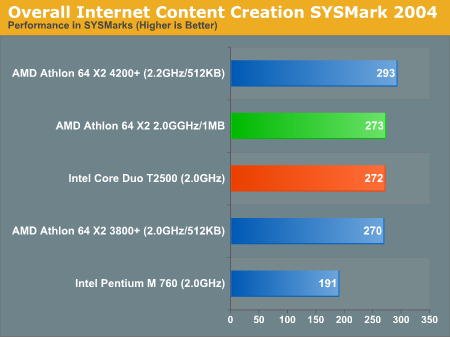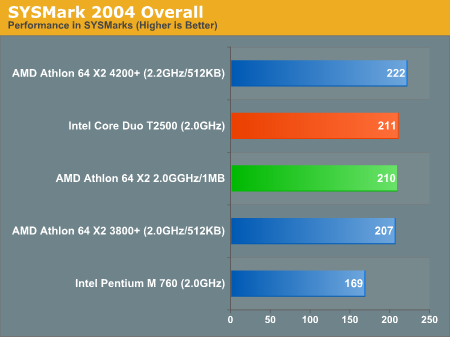Intel Core Duo (Yonah) Performance Preview - Part II
by Anand Lal Shimpi on December 19, 2005 12:55 PM EST- Posted in
- CPUs
Overall System Performance using SYSMark 2004
Office Productivity SYSMark 2004
SYSMark's Office Productivity suite consists of three tests, the first of which is the Communication test. The Communication test consists of the following:
Compared to the Athlon 64 X2, the Core Duo T2500 manages to slightly outperform the X2 3800+, but moving to a larger cache helps the X2 narrow that already small gap. Even though the Core Duo has a one-point lead, given the percentage, we'd call this one a tie.
The breakdown of the Office Productivity SYSMark 2004 score is listed below, higher numbers mean better performance:
ICC SYSMark 2004
The first category that we will deal with is 3D Content Creation. The tests that make up this benchmark are described below:
The breakdown of the ICC SYSMark 2004 score is listed below, higher numbers mean better performance:
Office Productivity SYSMark 2004
SYSMark's Office Productivity suite consists of three tests, the first of which is the Communication test. The Communication test consists of the following:
"The user receives an email in Outlook 2002 that contains a collection of documents in a zip file. The user reviews his email and updates his calendar while VirusScan 7.0 scans the system. The corporate web site is viewed in Internet Explorer 6.0. Finally, Internet Explorer is used to look at samples of the web pages and documents created during the scenario."The next test is Document Creation performance:
"The user edits the document using Word 2002. He transcribes an audio file into a document using Dragon NaturallySpeaking 6. Once the document has all the necessary pieces in place, the user changes it into a portable format for easy and secure distribution using Acrobat 5.0.5. The user creates a marketing presentation in PowerPoint 2002 and adds elements to a slide show template."The final test in our Office Productivity suite is Data Analysis, which BAPCo describes as:
"The user opens a database using Access 2002 and runs some queries. A collection of documents are archived using WinZip 8.1. The queries' results are imported into a spreadsheet using Excel 2002 and are used to generate graphical charts."

Compared to the Athlon 64 X2, the Core Duo T2500 manages to slightly outperform the X2 3800+, but moving to a larger cache helps the X2 narrow that already small gap. Even though the Core Duo has a one-point lead, given the percentage, we'd call this one a tie.
The breakdown of the Office Productivity SYSMark 2004 score is listed below, higher numbers mean better performance:
| OP SYSMark 2004 Score Breakdown | AMD Athlon 64 X2 4200+ | AMD Athlon 64 X2 3800+ | AMD Athlon 64 X2 2.0GHz/1MB | Intel Core Duo T2500 | Intel Pentium M 760 |
| Communication | 148 | 144 | 146 | 146 | 140 |
| Document Creation | 219 | 204 | 211 | 215 | 203 |
| Data Analysis | 145 | 136 | 138 | 138 | 117 |
ICC SYSMark 2004
The first category that we will deal with is 3D Content Creation. The tests that make up this benchmark are described below:
"The user renders a 3D model to a bitmap using 3ds max 5.1, while preparing web pages in Dreamweaver MX. Then the user renders a 3D animation in a vector graphics format."Next, we have 2D Content Creation performance:
"The user uses Premiere 6.5 to create a movie from several raw input movie cuts and sound cuts and starts exporting it. While waiting on this operation, the user imports the rendered image into Photoshop 7.01, modifies it and saves the results. Once the movie is assembled, the user edits it and creates special effects using After Effects 5.5."The Internet Content Creation suite is rounded up with a Web Publishing performance test:
"The user extracts content from an archive using WinZip 8.1. Meanwhile, he uses Flash MX to open the exported 3D vector graphics file. He modifies it by including other pictures and optimizes it for faster animation. The final movie with the special effects is then compressed using Windows Media Encoder 9 series in a format that can be broadcast over broadband Internet. The web site is given the final touches in Dreamweaver MX and the system is scanned by VirusScan 7.0."

The breakdown of the ICC SYSMark 2004 score is listed below, higher numbers mean better performance:
| ICC SYSMark 2004 Score Breakdown | AMD Athlon 64 X2 4200+ | AMD Athlon 64 X2 3800+ | AMD Athlon 64 X2 2.0GHz/1MB | Intel Core Duo T2500 | Intel Pentium M 760 |
| 3D Content Creation | 271 | 248 | 251 | 264 | 181 |
| 2D Content Creation | 340 | 312 | 314 | 323 | 238 |
| Web Publication | 274 | 254 | 257 | 236 | 162 |











103 Comments
View All Comments
fitten - Tuesday, December 20, 2005 - link
Which should make you think about the supposed "magic" of the on-die memory controller that everyone constantly raves about as being *the* reason why the Athlon64 is as good as it is (hint: there are other reasons, the IMC is just one piece of why).
Marmion - Monday, December 19, 2005 - link
I don't get it why everyone expects a mobile chip to out-perform a desktop chip.Yonah/Core Duo is specifically a low power optimised dual core processor for laptops. Its fine to use it as an indication of the future conroe/merom, but bear in mind that these will see faster clocks, further optimisations for their specific use (desktop/mobile respectively).
Next month, Intel will have no competition for dual core laptops untill the Turion X2 comes out. Will you think that the mobile version of a desktop processor will be able to perform the same? No, because of optimisations for the all-important mobility factor (battery-life and weight).
If you want an uber-powerful desktop replacement X2 processor-powered laptop, you can do that now. But expect no battery life and an aching back or a soar arm from carrying around a 4kg+ brick. So, Intel is now offering a laptop processor, capable of performing similarly to a desktop processor, but with low power consumption, long battery life and low weight.
What am I trying to say? A Turion X2 may be slower than current Athlon X2s and yes I know 65nm vs 90nm. It probably won't be faster anyway, so Intel have a fast, efficient and cheap processor - hey you expect Turion X2 to be as cheap as the single core version?
Apples to oranges? Get over it! The Core Duo uses DDR2, AMD X2 DDR. Intel FSB, AMD Mem controller. You will never get an apples to apples comparison - its business, competition, differentiated products, call it what you like, you buy AMD, you use different RAM, different Mobos, different drivers to Intel, end of story, so its a comparison of platforms, not CPU.
*end rant*
fitten - Tuesday, December 20, 2005 - link
They don't... and that's the point and why many are impressed with Yonah... that it *does* perform favorably to a desktop platform.
Leper Messiah - Monday, December 19, 2005 - link
how do you know its going to be cheap? As far as I have seen, there are no prices released for these processors yet. And do you wanna know why we're somewhat dissapointed? Intel (and its fanbois) have been talking about how this new arc. is supposed to be the next big thing. In its current form, its not really.stateofbeasley - Monday, December 19, 2005 - link
http://www.theinquirer.net/?article=26062">http://www.theinquirer.net/?article=26062Price points are the same as the current platform.
Yonah is not NGMA. Yonah is a P6 family processor.
People must read the news before they post!!!!
coldpower27 - Monday, December 19, 2005 - link
This isn't really new architecture, the next big thing is supposed to be Intel's NGMA, where alot of changes are going to be made.KayKay - Monday, December 19, 2005 - link
I am an AMD fanboybut the results (power consumption esp.) are very impressive
guess intel wants to keep things competitive
hope amd ups the ante in response
eetnoyer - Monday, December 19, 2005 - link
With AMD announcing the use of SiGe in processors coming up very soon, it looks like they could still get a decent drop in power consumption at 90nm. I'd guess that's what they're waiting for to release the Turion x2. I doubt that it will be quite enough to match the power consumption of Yonah, but should mostly suffice until the 65nm shrink. It will also apparently serve to greatly reduce the area required for L2 cache by shrinking the cells. Once that happens I imagine that AMD will hold a small power/performance lead over Merom/Conroe/Woodcrest since adding 64 bit will tend to up their power consumption somewhat. At that point, AMD will be using SOI and SiGe, while Intel will only be using SiGe.As for continuing the ramp of frequencies, I don't think that it's going to play a hugely significant role going forward. That's why everyone is going multi-core these days. It looks like rough performance parity is here to stay between the two. What I think AMD is aiming at is a duopoly in the CPU market. That is the point of the lawsuit, and the greatly expanding capacity that AMD is targeting (Fab36, Chartered, Fab38, etc...). What Intel really needs to worry about is AMD's ability to increase their brand awareness and supply large vendors reliably. Once that happens, Intel will need to compete on price. While AMD is very comfortable living on $100 ASP, that would be catastrophic to Intel's bottom line. I think over the next few years (barring any catastrophic screw-ups by AMD) we are going to see alot of cost-cutting at Intel.
Sorry for the off-topic ramblings, but I tend to look at things from an investors' POV.
Leper Messiah - Monday, December 19, 2005 - link
So I guess the biggest question for these (at least to me, since I don't have a need for an uber-lappy) is price and a converter for a mobo, and I guess OC-abilty. If they can match clock speeds of the x2s (2.6GHz+) and come out to be cheaper, then I might consider buying one of these, but I don't see AMD's desktop market being threatened, considering Intel's last gasps with netburst (let it die already!).If AMD can milk another 400MHz or so out of its K8 arctechture in its current form, they'll stay competitive with mermom it seems to me. Yonah certainly isn't the AMD killer the intel fanboi's have been heralding it as though.
fitten - Tuesday, December 20, 2005 - link
I've seen a number of "reports" of these Yonahs (Core Duo) hitting 2.5GHz quite easily without even raising the voltage. It's "as if" it were designed to run in the 2.5-2.6GHz range but not released that way... yet.